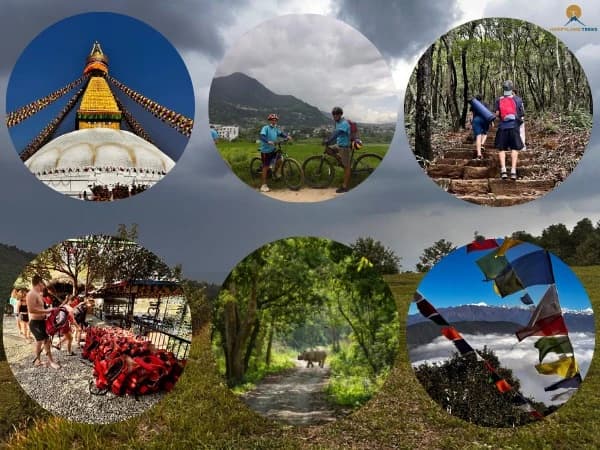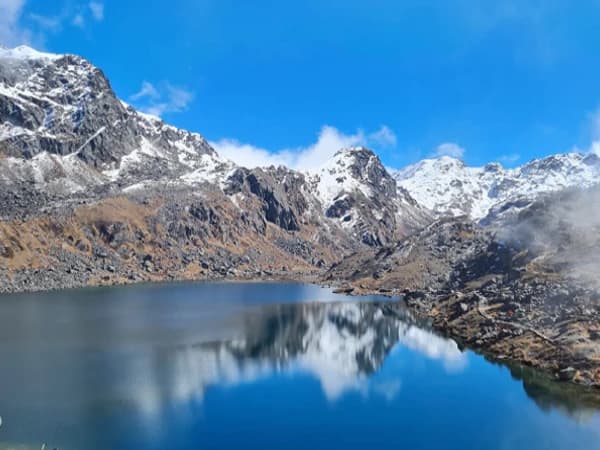Exploring the Routes to the Summit
There are several routes to the summit of Mount Everest, with the Southeast Ridge being the most popular. The Northeast Ridge and North Ridge are also often used by experienced climbers, though these routes can be more difficult and require specialized skills. The knife-edge southeast ridge offers spectacular views but presents a narrow and dangerous climb. Intermittent rock steps, snow-covered rock bands, and rock walls make these routes a challenging endeavor.
One of the most famous routes is the Khumbu Valley route, which leads climbers from the Everest Base Camp up through the Hillary Step and to the summit. It’s here where climbers are likely to face some of the harshest conditions: bad weather and substantial time spent in extremely low temperatures and extreme altitude.
Mount Everest Base Camp
Climbers first reach Everest Base Camp, a crucial staging point for the climb to the summit. At this location, climbers begin their acclimatization process, a vital step in preparing the body to handle the extreme altitude. The base camp offers stunning views of the surrounding peaks, including the towering Ama Dablam and the majestic Khumbu Glacier. It’s also where most climbers adjust their equipment and gather the strength to tackle the summit ridge. The Everest Base Camp is often filled with climbers with ice axes and oxygen masks, preparing for their journey ahead.
The Landscape and Beauty of Mount Everest
The beauty of Mount Everest and the surrounding Himalayas Mountains is beyond compare. From the summit, you can see a mountain landscape that stretches as far as the eye can see, with the peaks of Mount Ama Dablam, Mount Lhotse, and other Himalayas Mount giants rising in the distance. The contrast of the snow-covered rock bands and the black rock formations adds to the mountain’s beauty.
The view of Everest from the top is often described as surreal, especially at sunset, when the silhouette of climbers against the golden light creates a breathtaking image. The summit, often referred to as Peak XV, is not just a physical location but also a symbol of human perseverance, marking the boundary where vegetation growth ends and the realm of ice and rock begins.
Challenges Beyond Climbing
Climbing Mount Everest is not without its dangers. The extreme conditions, thin air, and oxygen masks are only the beginning. The presence of Chinese climbers, Polish climbers, and climbers from around the world has brought attention to the dangerous weather conditions and the threat to climbers who attempt to scale Everest.
The mountain’s altitude sickness, high winds, and the need for careful oxygen management are not to be underestimated. Climbers must also navigate diagonal climbs and rock walls along the Khumbu region's difficult routes, making it a truly difficult climb for even the most experienced.
FAQ: Climbing Mount Everest
1. Why does it cost $40,000 to climb Mount Everest?
The cost to climb Mount Everest typically ranges from $30,000 to $80,000, with $40,000 being a common figure. The expense covers a variety of factors such as permits (which cost around $11,000), logistical support, guides, and Sherpas, as well as the required equipment, supplemental oxygen, base camp facilities, and insurance. The cost also reflects the difficulty and dangers of the climb, including the harsh weather conditions, the need for expert climbing guides, and the necessary infrastructure to ensure the safety of climbers.
2. How far can you see from the top of Mount Everest?
From the summit of Mount Everest, you can see for hundreds of miles on a clear day. The Himalayas Mountains stretch out below you, with views of Lhotse, Ama Dablam, and other towering peaks. The Earth's curvature limits the distance, but you can see up to 200 miles (about 320 kilometers) in clear conditions. The visibility largely depends on the weather and atmospheric clarity, which can be affected by the extreme altitude and winds.
3. How does the peak of Mount Everest look like?
The peak of Mount Everest is a sharp, triangular summit with a small flat area where climbers take their photos and celebrate their achievement. The summit is typically covered in snow and ice, surrounded by jagged ridges and rocky outcrops. The surrounding Himalayas stretch as far as the eye can see, with stunning panoramic views of the Khumbu Glacier and Ama Dablam. The area is very cold, and the wind can be fierce, making the peak appear even more majestic and inhospitable.
4. What is the 2pm rule on Everest?
The 2pm rule on Everest is a guideline for climbers to start descending by 2:00 PM to avoid the risks of being caught at high altitudes after dark. The reasoning behind this rule is that climbing above 8,000 meters (the "Death Zone") requires additional time for acclimatization, and any delays could lead to serious consequences. Climbers who reach the summit later than 2:00 PM risk being caught in extreme weather conditions and exhausting their oxygen supplies, making it critical to begin the descent before the afternoon turns to evening.
5. How far can you see from the top of Mount Everest?
As mentioned earlier, from the summit of Mount Everest, you can see for miles, typically around 200 miles (320 kilometers), in clear weather. The vast Himalayan panorama, including the Khumbu region, Ama Dablam, and other peaks, is visible from this incredible height. The view is one of the most stunning sights a climber can experience, with the vastness of the surrounding mountains offering a humbling and awe-inspiring perspective. However, visibility depends largely on the weather conditions, which can be extreme and change rapidly at such a high altitude.
Conclusion
The view from the top of Mount Everest is like no other, offering climbers a unique perspective on the world’s tallest mountain and the surrounding Himalayas Mount range. While the challenges of climbing Everest are immense, the rewards for those who succeed are worth every bit of effort. From the stunning Himalayas panorama to the beautiful Mount Everest, the experience is nothing short of awe-inspiring. For those who dream of standing at the top of the world, Mount Everest remains the ultimate adventure.



